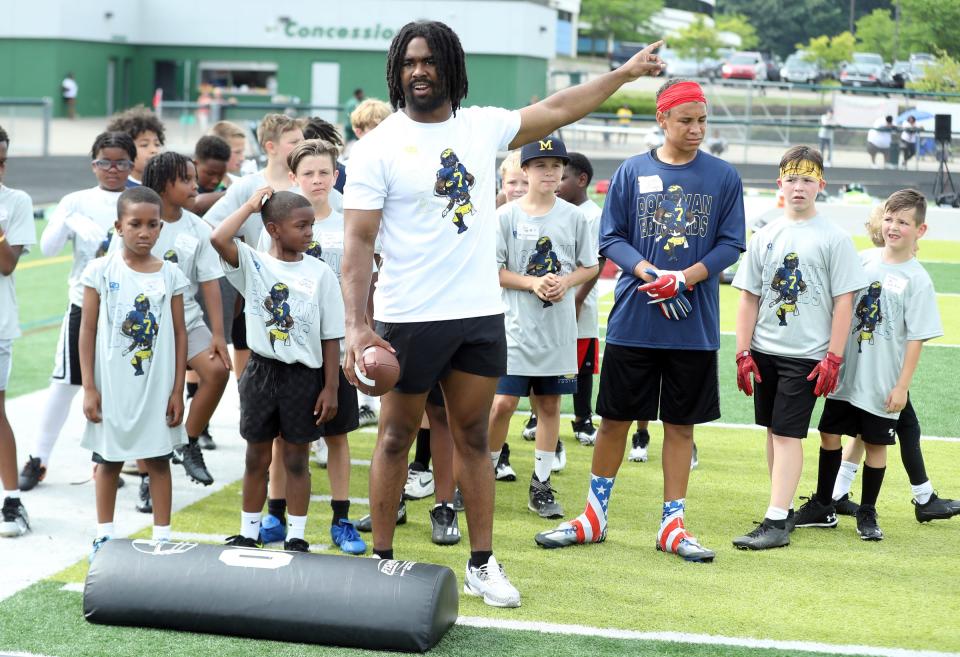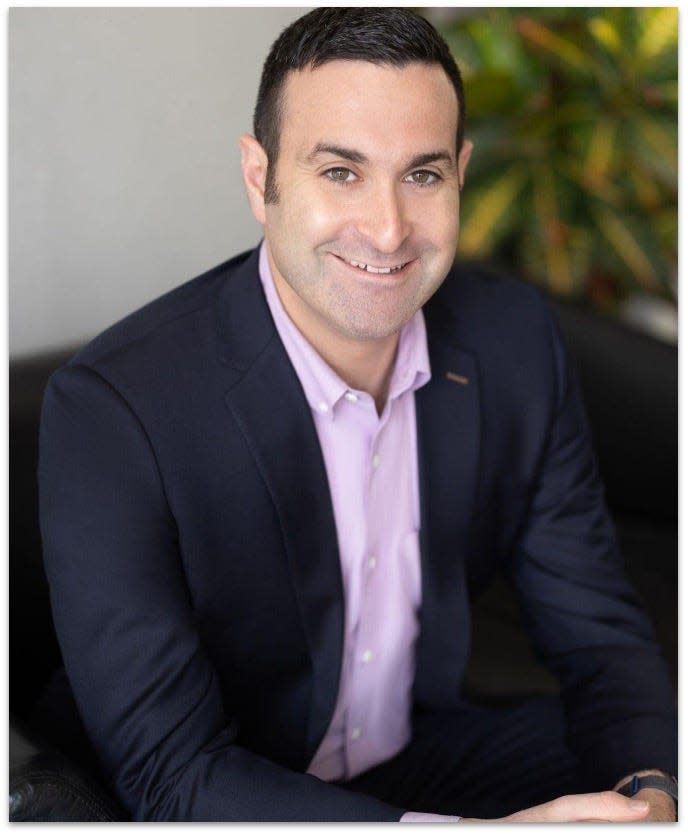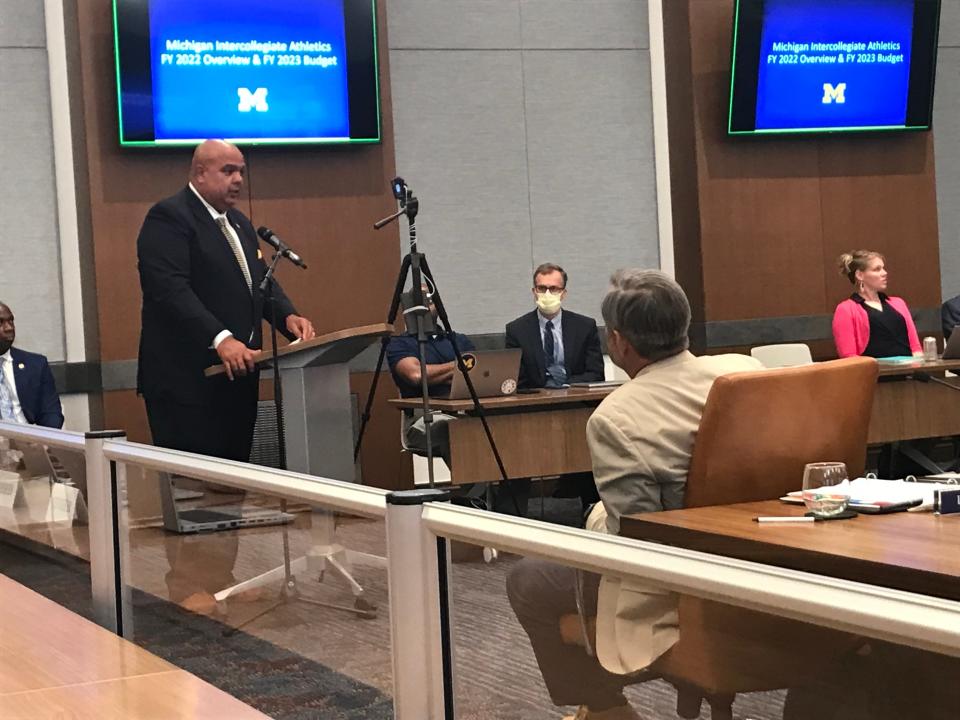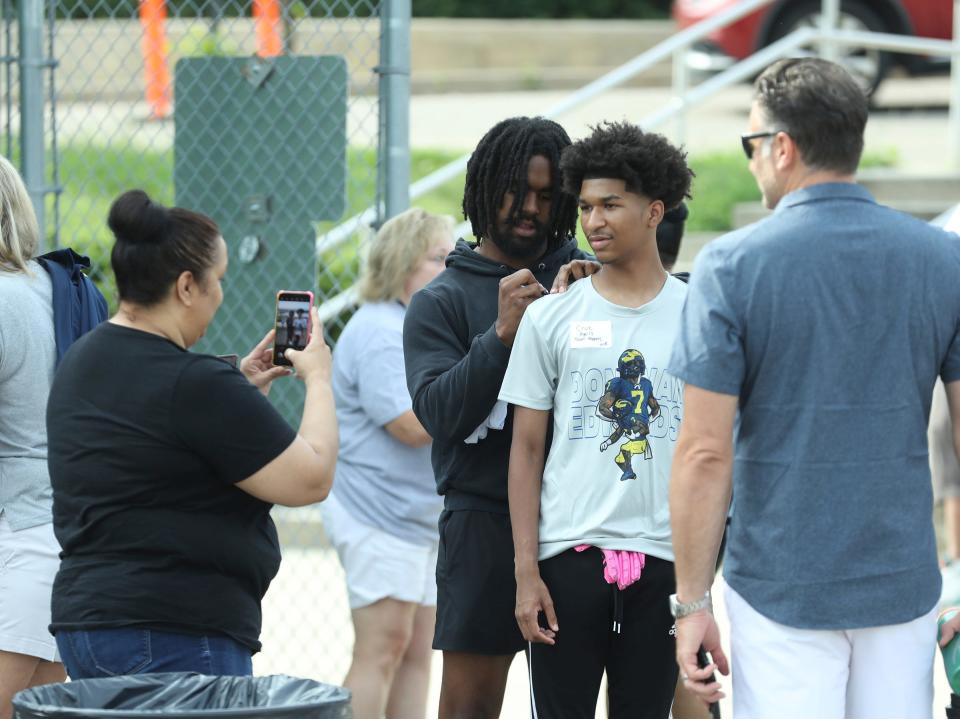Michigan athletics finds its footing in NIL world. Here's what took so long
Some dates just mean more.
In the world of collegiate athletics, July 1, 2021, is one of them — when the NCAA Board of Directors' approval for college athletes to receive financial compensation and profit off their name, image and likeness became official.
Pandora's box was opened.
"The most dramatic change in college athletics in decades," Michigan Regent Jordan Acker called it in a recent conversation with the Free Press. "Well, really ever."
Widely seen as a long overdue endeavor for thousands of athletes to get rightful compensation through their marketability, NIL often can be as wholesome as its original intention: To force the NCAA, a self-proclaimed non-profit with billions of dollars in its ecosystem, to allow the young adults who grew it into a multibillion-dollar enterprise to make money, too.
Michigan basketball walk-on Cooper Smith, who spent months organizing his own three-day basketball camp — "Ballin' On A Break" in South Lyon earlier this month — is a perfect example.
Inspired by the hoops camps he grew up attending — which were often run by his father, Jay, who's now Michigan basketball's director of player personnel, or his uncle, Ty McGregor, a former assistant at GVSU — Smith wanted to head one of his own.
His mother, Tymi, was on hand and helped with registration and the occasional "boo boo," and his younger sister Cazzi, 18, "did a little bit of everything," but it was his brain child.
Because of NIL, not only was Smith able to line his pockets, but he brought along two of his more well-known teammates, Tarris Reed Jr. and Will Tschetter. Their social platforms got more campers to attend.

It also got them paid.
"This is NIL in its purest form," Smith said on the final day, pointing to the throngs of pre-teens who'd just run off the court for a water break. "I'm not doing this camp for my dad or my uncle, I'm not showing up for an hour and signing a couple autographs and leaving. This is mine."
Michigan football star running back Donovan Edwards had a similar sentiment this July 1, when he ran across the field, setting up bags for campers at the second annual summer camp at his alma mater, West Bloomfield High School.
"I love this day," he told the Free Press. "It's for the kids."
Edwards didn't pretend all of his NIL endeavors are so noble.
"I'm catching a flight right after this to go to Chicago for a NASCAR event," he said. "One of the agencies looking at me, they just asked me if I wanted to go, so of course I plan on going and asking one of the drivers if I can take that thing for a spin."
'Do things the right way'
For every heartwarming story, there's another that gives reason for pause.
However, with few rules and regulations and even fewer ways to enforce them — there remain no federal regulations to provide guidelines, and so laws vary from state to state — the college sports arms race kicked into high gear as NIL was instituted.
It took just one month before former Florida baseball player Eddie Rojas and sports attorney Darren Heitner, strategized the idea of compiling boosters into one group and pooling their money, a concept they called a "collective."
It spread like wildfire, but there was one problem for the fans of the school in Ann Arbor; U-M didn't seem too interested in participating. At least not at first.
"I think there’s been a rush from fans to say, ‘Everyone else is figuring it out quickly, why aren’t we?’ and I’m not sure that’s true," Acker said. "If you talk to athletic directors, presidents and board chairs across the country, they see these same struggles, what is it that our institution does best?
"What Michigan struggled with is aligning both the donor goals and the values of the institution along one or more collectives."
Today, there are hundreds of such entities across the country, connected with nearly every major Power Five institution. That includes Michigan, which as of this spring was affiliated with five collectives: Stadium & Main, Hail! Impact, MGoDAO, Ann Arbor NIL Club and Champions Circle.

It's not as though U-M was completely uninvolved in the space prior to this spring — last winter, Champions Circle spearheaded the "one more year" fund that helped entice Blake Corum, Trevor Keegan and Zak Zinter to return for their senior seasons — but it was to a much lesser extent than its counterparts.
"Michigan’s (NIL) evolution has been in a lot of ways how Michigan’s evolved on things in the past," Acker said. "The perfect example is night games; they were among the last to embrace it, but now they have embraced it significantly."
Leaders at Michigan had their reasons for not wanting to jump straight into the deep end with NIL, Acker said.
For starters, the feeling was NIL was moving a thousand miles a minute. U-M brass didn't want to get ahead of itself like Florida did last winter, when the aforementioned "Gator Collective" was the epicenter of one of the most infamous NIL mishaps.
Four-star quarterback Jaden Rashada had committed to Miami (Florida) in June 2022, but he and the Gator Collective reportedly agreed to a $13 million NIL deal should he attend school in Gainesville. Days later, the senior flipped his commitment to Florida.
But the money Rashada was promised reportedly fell through; less than a month later, he asked out of his scholarship.
"People have been misled by stories as to what the marketplace actually looks like for student athletes in this space," Acker said. "What the reality is, and we’re starting to see this happen nationally as we get to this more normal place, is that’s not the case.
"You have to work at NIL to get NIL money — even here, there is an expectation you’ll get paid because you play for Michigan and are a Michigan athlete. No, it requires a lot of work."
The second problem, and perhaps more relevant for U-M, is that promising a recruit money in order to get him or her enrolled is called an "inducement" and is illegal in Michigan by both NCAA bylaws and state law. While Michigan athletic director Warde Manuel is a proponent of NIL, as a former highly recruited athlete himself, pay-for-play is not the way he wanted U-M operating.
"Telling kids that, ‘We will pay you X if you come to our institution,' that’s not a part of where intercollegiate athletics should be," Manuel said last month on the university's “Conqur’ing Heroes” podcast. “But it is something that we have to deal with.
“I’ve had several meetings with collectives that are supporting our student-athletes, and what I ask them to do is do things the right way," Manuel said. "If student-athletes are going to benefit from a collective and what they decide to do, that they benefit from actually doing what you’re providing, that there are no inducements, that we don’t get into a situation where we’re talking to recruits and they get to some of our recruits and promise them money if they to come to Michigan."

Need for alignment
Beyond the ethics question, U-M needed a leader to forge the path ahead.
Six months after NIL went into affect, university president Mark Schlissel was fired. Manuel, the leader of one of the most lucrative college athletics departments in the nation, was tasked with steering a ship in unsettled waters.
As the rest of the collegiate world raced by, U-M's Board of Regents tabbed former president Mary Sue Coleman as a stop-gap option to fill her old post while they searched for permanent candidates. Coleman had an extensive résumé, but ushering the university into the new wave of college athletics was never part of it.
"With all due respect ... it was really Mary Sue's job to keep things afloat," Acker said. "The timing wasn't great, but it could only be solved with a president getting the team to row in same direction and to even know what direction that even is.
"Michigan never lacks for resources or deep pockets who are generous, but it takes Michigan a longer amount of time to find where that alignment is."
New school president Santa Ono brought the "alignment," which Acker first called a buzzword, before he elaborated.
"Everyone from the board, president, athletic director, coaches, student athletes, marketing staff, development staff and on and on has to be pulling in same direction," he said. "It also means they have to believe in the mission of whatever they’re pulling towards."
Michigan feels it has finally found it, not just with Ono, but with the university-backed NIL M Power Program.
Dubbed as "a Brand for Life program, designed to assist the next generation of Wolverine football players as they navigate internships, mentorships, entrepreneurship and NIL," U-M announced in mid-June it hopes this program can get a base stipend for every player on the roster.
The intention beyond that is for the program serves as a "conduit" for players to connect with donors and businesses. That's the alignment U-M was looking for, in academics and athletics.
"From things like internships to marketing, to all of the things Michigan and our alumni network does well, it’s an enormously good push," Acker said. "Now, that doesn’t mean we’re there yet and we’re not. We need to do whatever we can to fully fund it.
"But it’s far closer to what (boosters) are used to giving for."

'There's a better model'
Although Michigan has started to find its footing in the new world and how it has decided to embrace NIL, the space continues to evolve.
It doesn't seem to be stopping anytime soon, which includes not only collectives and their long-term viability, but in some cases, their legality.
“People throughout the country are realizing bundling together dollars, for lack of a better term, from wealthy donors is not a sustainable model for collectives success,” Acker said. “Then, the idea of a 501c-3 model where you’re essentially paying students to engage in charitable activities while getting tax deductible donations may not even be legal and in fact is likely not legal in a lot of respects.
“So I think it’s forcing these organizations to evaluate their existence and how they plan on engaging with student athletes moving forward.”
So what's next?
The NCAA is pushing for federal legislation to create a uniform NIL standard, which would provide at least limited antitrust protection and declare that student-athletes are not employees of their schools, conferences or the NCAA.
Acker said institutions across the country should read the writing on the wall, especially when the California Assembly passed a bill which would allow college athletes to be paid by schools.
"The thing you’ll see from a lot of these big schools, especially these donors, will find there’s better model and that better model is revenue sharing," he said. "While NCAA has made it illegal now, and California is waiting, privately schools should be having those conversations.
"And some are, but not enough."
There are things Acker said he wishes U-M had done differently on a macro level, such as getting involved in collectives sooner. He believes the university needs to better communicate to all of its communities at the top of the list.
But Acker has flown around the country to NIL conferences, met with board members and presidents, lawyers and executives. He came back with a conclusion — sure, there are things U-M could have done better, but:
"Whenever you look at something in a rearview mirror, you can always find something you wish you had done better, I think we all do," Acker said. "But I think for Michigan, the most important thing always, always, always was alignment
"I think it will have been worth the wait to do it right."
Contact Tony Garcia at apgarcia@freepress.com. Follow him on Twitter at @realtonygarcia.
This article originally appeared on Detroit Free Press: Why Michigan athletics took while to figure out name, image, likeness

